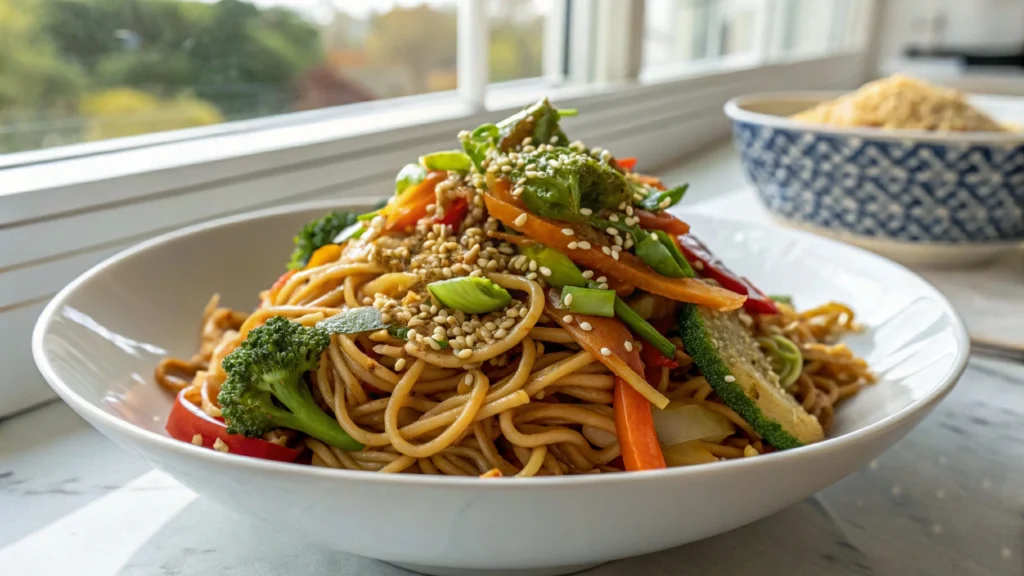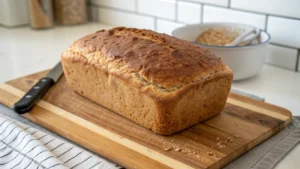Imagine the sizzle of noodles on a hot griddle, the sweet-savory aroma wafting through a bustling Japanese festival. Yakisoba, a beloved stir-fried noodle dish, brings that street food magic to your kitchen. With its chewy wheat noodles, crisp vegetables, and tangy sauce, it’s nowonder yakisoba is a global favorite. This guide offers an authentic yakisoba recipe that’s easy to follow, even for beginners. Whether you’re craving a quick weeknight meal or a dish to impress friends, you’ll love how simple and delicious this recipe is.
Why Yakisoba?
Yakisoba, meaning “fried noodles” in Japanese, is a versatile dish with Chinese roots that became a staple in Japan’s post-war street food scene. It’s customizable, budget-friendly, and packed with flavor. Our recipe uses chicken for a widely accessible protein, paired with a homemade sauce that captures the dish’s signature taste.
“Yakisoba is the ultimate comfort food simple ingredients, bold flavors, and endless variations.”
Namiko Hirasawa Chen, Just One Cookbook
What is Yakisoba?
Definition and Origins
Yakisoba is a Japanese stir-fried noodle dish made with wheat-based noodles, vegetables, protein, and a sweet-savory sauce. Despite its name, it doesn’t use buckwheat soba noodles but rather Chinese-style wheat noodles called chuka soba. The dish likely originated in Japan’s Taisho era, evolving from Chinese chow mein and becoming a street food staple in Asakusa, Tokyo, as noted by food historian Shogo Shiozaki Just One Cookbook.
Cultural Significance
You’ll find yakisoba sizzling on teppan griddles at Japanese festivals (matsuri), baseball stadiums, and teppanyaki restaurants. Its affordability and adaptability made it a hit in post-war Japan, where food stalls used simple ingredients to feed hungry crowds. Today, it’s a comfort food enjoyed worldwide, from convenience store yakisoba-pan (noodles in a bun) to gourmet restaurant versions.
Key Characteristics
- Noodles: Chewy, wheat-based, pre-steamed for quick cooking.
- Sauce: A tangy blend of soy sauce, Worcestershire sauce, ketchup, and sugar.
- Ingredients: Typically includes cabbage, carrots, onions, and a protein like chicken or beef.
- Garnishes: Aonori (green seaweed flakes), beni shoga (pickled ginger), and katsuobushi (bonito flakes) add flair.
Ingredients for Yakisoba
To make authentic yakisoba, you’ll need a mix of pantry staples and fresh ingredients. Here’s a breakdown:
Yakisoba Noodles
- What to Use: Pre-steamed yakisoba noodles (e.g., Myojo or Maruchan brands), available at Asian grocery stores or online.
- Where to Buy: Check refrigerated or freezer sections of Japanese, Korean, or Chinese markets.
- Alternatives: Ramen noodles or shirataki noodles for a low-carb option Shirataki Yakisoba.
- Tip: Rinse noodles under warm water to loosen them before cooking.
Vegetables
- Core Veggies: Cabbage (chopped), carrots (julienned), onions (thinly sliced).
- Optional Additions: Bean sprouts, bell peppers, or shiitake mushrooms for extra texture.
- Why These Work: They stay crisp when stir-fried, balancing the noodles’ chewiness.
Protein
- Primary Choice: Chicken (breast or thigh, thinly sliced for quick cooking).
- Alternatives: Beef (thinly sliced) or tofu for a vegetarian version.
- Preparation: Marinate chicken in a splash of soy sauce for added flavor (optional).
Yakisoba Sauce
- Homemade: A blend of soy sauce, Worcestershire sauce, ketchup, sugar, and optional oyster sauce.
- Store-Bought: Otafuku brand is a popular choice Yakisoba Sauce Recipe.
- Note: For those avoiding fish-based ingredients, use vegan Worcestershire sauce.
Garnishes
- Traditional: Aonori, beni shoga, katsuobushi, Japanese mayonnaise.
- Where to Find: Asian grocery stores or online retailers.
| Ingredient | Quantity | Notes |
|---|---|---|
| Yakisoba Noodles | ¾ lb (340g) | Pre-steamed, rinse before use |
| Chicken Breast | ½ lb (225g) | Thinly sliced, high-quality preferred |
| Cabbage | 2 cups, chopped | Core ingredient for crunch |
| Carrots | 1 medium, julienned | Adds color and sweetness |
| Onion | ½ medium, sliced | Enhances savory flavor |
| Soy Sauce | 2 tbsp | For sauce and optional marinade |
| Worcestershire Sauce | 2 tbsp | Use vegan version if preferred |
| Ketchup | 2 tbsp | Adds tanginess to sauce |
| Sugar | 1 tsp | Balances flavors |
| Aonori | 1 tsp | Optional garnish for umami |
| Beni Shoga | 1 tbsp | Pickled ginger for brightness |
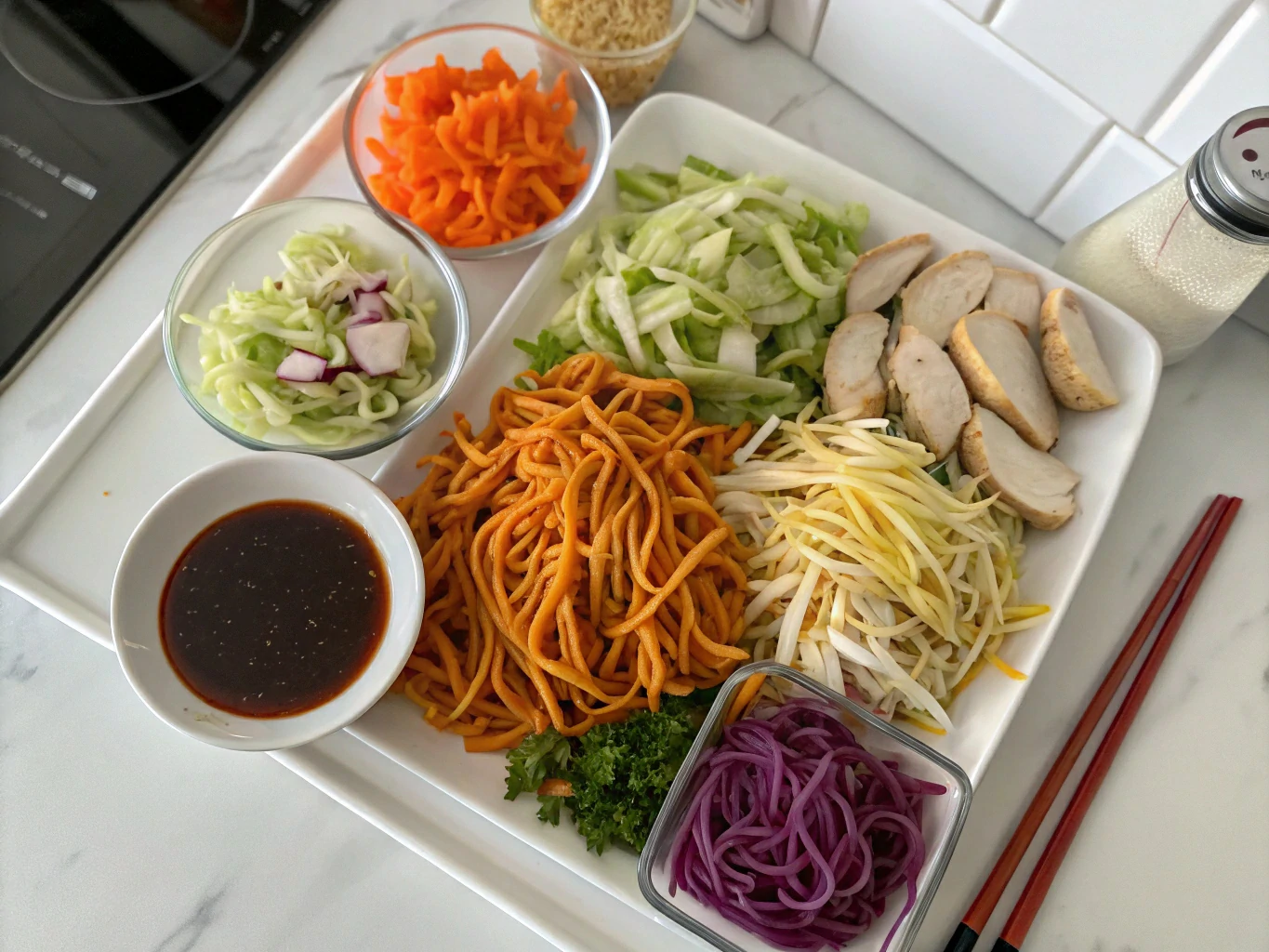
- Prompt: “A colorful array of yakisoba ingredients including yakisoba noodles, sliced chicken, chopped cabbage, julienned carrots, and sauce components on a rustic wooden table.”
How to Make Yakisoba Sauce
The yakisoba sauce is the heart of the dish, delivering its signature sweet-savory-tangy flavor. Making it at home is easy and lets you adjust the taste to your liking.
Ingredients
- 2 tbsp soy sauce
- 2 tbsp Worcestershire sauce (or vegan alternative)
- 2 tbsp ketchup
- 1 tsp sugar
- 1 tbsp oyster sauce (optional, omit for vegetarian)
Instructions
- In a small bowl, combine soy sauce, Worcestershire sauce, ketchup, sugar, and oyster sauce (if using).
- Whisk until sugar dissolves and the sauce is smooth.
- Taste and adjust with more sugar for sweetness or soy sauce for saltiness.
- Set aside or store in an airtight container in the fridge for up to a week.
Store-Bought Options
If you’re short on time, try Otafuku yakisoba sauce, available at Asian markets or online. Look for brands with simple ingredients to maintain authenticity.
“A good yakisoba sauce should coat the noodles evenly, with a balance of sweet, salty, and tangy notes.”
Marc Matsumoto, No Recipes
Step-by-Step Yakisoba Recipe
This authentic yakisoba recipe serves 3 and takes about 30 minutes. Follow these steps for a restaurant-quality dish at home.
Preparation (10 minutes)
- Slice Vegetables: Chop cabbage, julienne carrots, and thinly slice onions.
- Prepare Chicken: Slice chicken breast thinly; marinate in 1 tsp soy sauce (optional).
- Rinse Noodles: Place yakisoba noodles in a colander and rinse under warm water to loosen.
Cook Noodles (5 minutes)
- Bring a pot of water to a boil.
- Add noodles and cook for 1 minute less than package instructions (about 1-2 minutes).
- Drain and rinse under cold water to prevent sticking.
Stir-Fry (15 minutes)
- Heat Pan: Heat 1 tbsp neutral oil (e.g., vegetable oil) in a large wok or griddle over medium-high heat.
- Cook Chicken: Add chicken slices, stir-fry until cooked through (3-4 minutes). Remove and set aside.
- Cook Vegetables: Add another 1 tbsp oil, then stir-fry onions, carrots, and cabbage until crisp-tender (4-5 minutes).
- Combine: Return chicken to the pan, add noodles, and pour in yakisoba sauce.
- Toss: Stir-fry for 2-3 minutes until noodles are coated and slightly charred.
Serve
- Divide yakisoba among plates.
- Sprinkle with aonori, beni shoga, and katsuobushi (if using).
- Drizzle with Japanese mayonnaise for extra richness (optional).

- Prompt: “A chef stir-frying yakisoba noodles with chicken and vegetables on a large griddle, with steam rising and a wooden spatula in hand.”
Variations and Customizations
Yakisoba is endlessly adaptable. Here are some popular variations:
Vegetarian Yakisoba
- Protein: Use firm tofu or shiitake mushrooms instead of chicken.
- Sauce: Omit oyster sauce and use vegan Worcestershire sauce.
- Tip: Add extra vegetables like bell peppers or bean sprouts for variety.
Beef Yakisoba
- Protein: Substitute chicken with thinly sliced beef (e.g., sirloin or ribeye).
- Preparation: Cook beef quickly to keep it tender.
Spicy Yakisoba
- Sauce: Add 1 tsp chili flakes or 1 tbsp sriracha to the sauce.
- Garnish: Top with chopped scallions for freshness.
Seafood Yakisoba
- Protein: Use shrimp or calamari for a coastal twist.
- Tip: Cook seafood separately to avoid overcooking, then add back with the sauce.
| Variation | Protein | Sauce Adjustment | Extra Ingredients |
|---|---|---|---|
| Vegetarian | Tofu/Mushrooms | Vegan Worcestershire | Bell peppers, bean sprouts |
| Beef | Thinly sliced beef | Standard sauce | None |
| Spicy | Chicken | Add chili flakes/sriracha | Scallions |
| Seafood | Shrimp/Calamari | Standard sauce | None |
Serving Suggestions
Garnishes
- Aonori: Adds a subtle umami flavor.
- Beni Shoga: Brightens the dish with tangy pickled ginger.
- Katsuobushi: Bonito flakes add a smoky depth.
- Japanese Mayonnaise: A creamy drizzle enhances richness.
Side Dishes
Pair yakisoba with:
- Miso Soup: A light, savory complement Miso Soup Recipe.
- Japanese Pickles: For a crunchy contrast.
- Simple Salad: Cucumber and sesame dressing for freshness.
Storage
- Refrigerate: Store leftovers in an airtight container for 1-2 days.
- Reheat: Warm in a skillet with a splash of water to revive texture.
- Freeze: Freeze cooked noodles for up to 1 month; thaw before reheating.
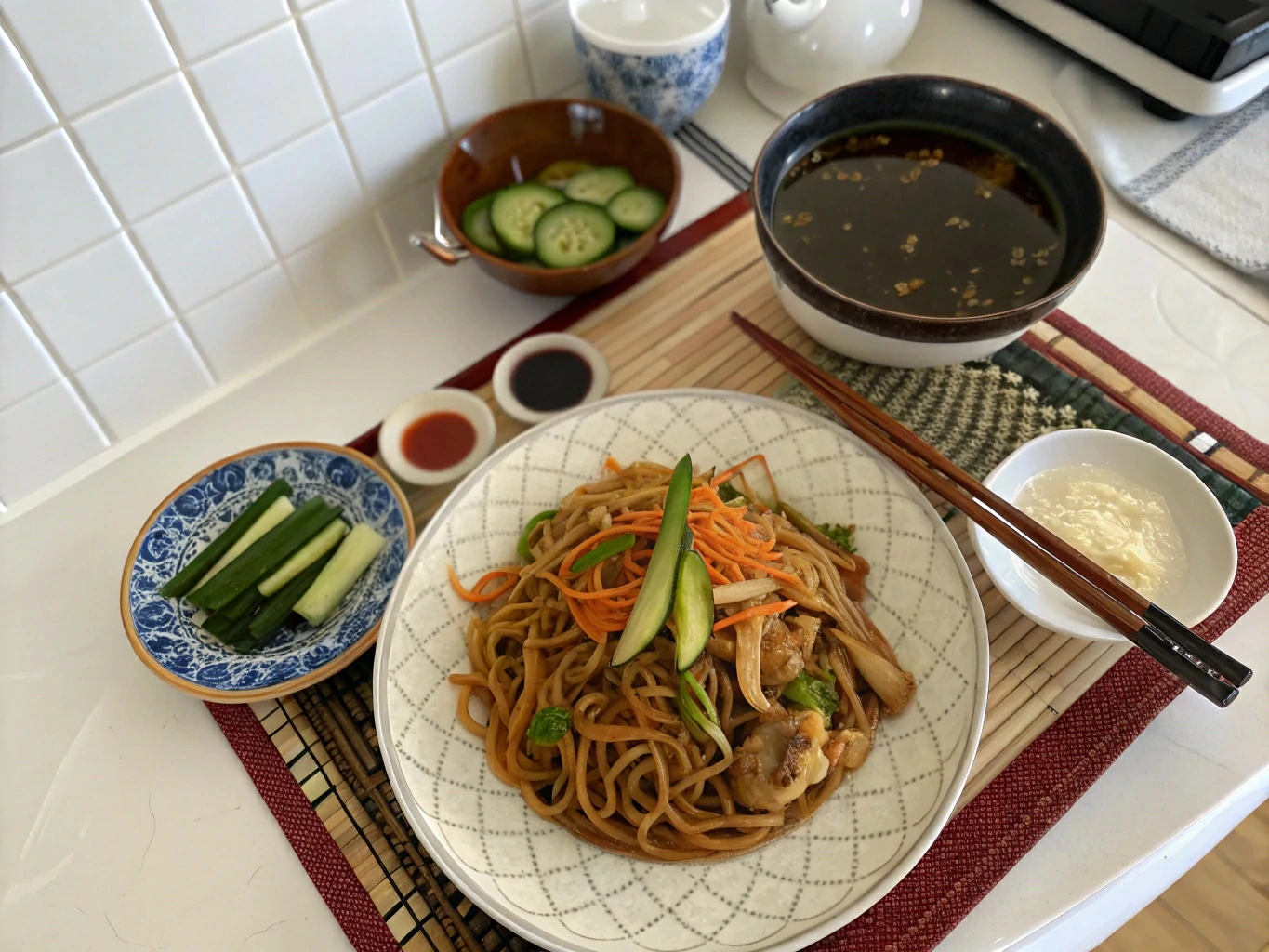
- Prompt: “A beautifully plated yakisoba dish with miso soup and Japanese pickles on the side, arranged on a traditional Japanese table setting.”
Frequently Asked Questions
Can I Use Ramen Noodles Instead of Yakisoba Noodles?
Yes, ramen noodles can work, but yakisoba noodles are pre-steamed for better texture. If using ramen, cook them al dente to avoid mushiness.
Is Yakisoba Gluten-Free?
No, standard yakisoba noodles are wheat-based. For a gluten-free version, try shirataki noodles or gluten-free ramen, and ensure the sauce is gluten-free.
How Can I Make Yakisoba Vegan?
Use tofu or mushrooms instead of chicken, and replace Worcestershire and oyster sauces with vegan alternatives. Check that garnishes like katsuobushi are omitted.
Can I Prepare the Sauce in Advance?
Absolutely! Make the sauce up to a week ahead and store it in an airtight container in the fridge. Shake or stir before using.
Related Recipes
Explore more delicious dishes on YumRecipeLand:
- Spicy Korean Tteokbokki: Craving another Asian noodle dish? Try these spicy rice cakes Tteokbokki Guide.
- Chicken Tacos: For a different take on chicken, these tacos are a hit Chicken Tacos Recipes.
- Ground Beef Recipes: Versatile beef dishes that pair well with yakisoba’s flavors Ground Beef Recipes.
- Broccoli Recipes: Add a healthy side to your meal Broccoli Recipes.
Conclusion
Yakisoba is more than just a noodle dish it’s a taste of Japanese street food culture that you can recreate at home. This authentic yakisoba recipe is easy, versatile, and bursting with flavor. Whether you stick to the classic chicken version or try a vegetarian or spicy twist, you’re in for a treat. Ready to bring the festival to your kitchen? Grab your ingredients and start cooking!
Sign up for our newsletter at YumRecipeLand for more mouthwatering recipes and cooking tips delivered to your inbox.
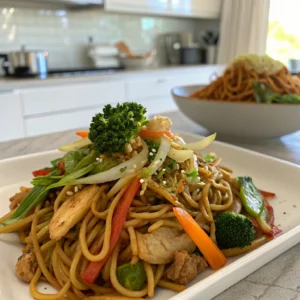
Yakisoba Noodles
Equipment
- Wok or Large Skillet
Ingredients
- 2 packs yakisoba noodles fresh or vacuum-packed
- 1/2 onion, sliced
- 1 cup cabbage, chopped
- 1/2 carrot, julienned
- 100 g pork belly or chicken thinly sliced
- 1 tablespoon vegetable oil
- 2 tablespoons yakisoba sauce store-bought or homemade
- pickled red ginger (beni shoga) optional for garnish
- aonori (seaweed flakes) optional for topping
Instructions
- Prepare the noodles according to package instructions if necessary (loosen with hot water if vacuum-packed).
- Heat oil in a wok or large skillet over medium heat. Add pork or chicken and cook until browned.
- Add onion, cabbage, and carrots. Stir-fry for 2–3 minutes until vegetables are slightly tender.
- Add the noodles and stir-fry, combining with meat and vegetables.
- Pour in yakisoba sauce and stir until evenly coated. Cook for another 2 minutes.
- Serve hot, garnished with pickled ginger and aonori if using.
